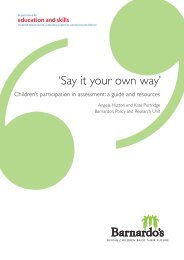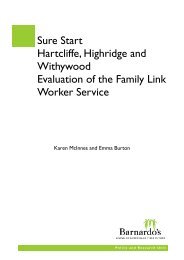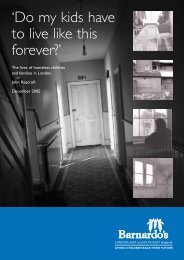Splintered Lives - Barnardo's
Splintered Lives - Barnardo's
Splintered Lives - Barnardo's
You also want an ePaper? Increase the reach of your titles
YUMPU automatically turns print PDFs into web optimized ePapers that Google loves.
Maggie O'Neill's (1995) action research project in Nottingham is an important source for<br />
understanding the complexity of some young women's entry into, and continued<br />
presence in prostitution. She argues that the variable and changing combinations of<br />
financial and emotional needs, coercion and association have to be understood and<br />
unpicked, if we are to make sense of why young people not only enter, but also remain<br />
in the sex industry (see, also Hoigard and Finstad, 1992).<br />
Association/economic need are often presented as differing and separate reasons for<br />
women's entry into prostitution. This is too simple, and does not reflect the<br />
complexity of many women's lives. For some women coercion and association led to<br />
their entry, but economic need keeps them there as a well as a sub-culture of similar<br />
and significant others. For others economic need led to their involvement but<br />
coercion and sub-cultural entrenchment keeps them there. The sub-cultural aspect is<br />
an important consideration; a sense of belonging to the network, friends who<br />
understand and do not judge, and feeling needed and wanted are centrally related to<br />
understanding women's continued involvement in prostitution (p11).<br />
Her work also highlights the particular problem of young care leavers (see also<br />
Linehan,1994).<br />
Some are young women who drift into prostitution on leaving care because of<br />
financial problems and their association with the street culture; others are clearly<br />
pimped and coerced into prostitution whilst in care through developing 'romantic'<br />
relationships with local pimps. All of these young women have profoundly sad<br />
backgrounds: child sexual abuse; physical and emotional abuse; family breakdowns;<br />
multiple placements in care. These result in extreme vulnerability and emotional<br />
neediness, since their needs have not been met within the organisation of residential<br />
care despite some very committed staff (p9).<br />
Linehan (1994) reports on estimates that 80% of 'rent boys' and 50% of young women<br />
working as prostitutes in London have been in local authority care, and notes the failure<br />
of Children Act provisions in relation to care leavers. A number of children's advocacy<br />
organisations have argued that the increased involvement of 16-18 year olds from the<br />
late 1980s is a direct consequence of the removal of an automatic right to income<br />
maintenance.<br />
A joint 1992 Police Foundation and National Children's Home (NCH) study (reported in<br />
Davies 1994a) of British children surviving on the streets echoes this, and Davies himself<br />
comments: '<br />
It always begins with the poverty of their origins, it moves through the bleak housing<br />
estate, the single parent, the whole family trapped by income support. It usually<br />
includes abuse - sometimes physical, sometimes sexual always psychological. It<br />
PAGE 61<br />
chapter<br />
9
















